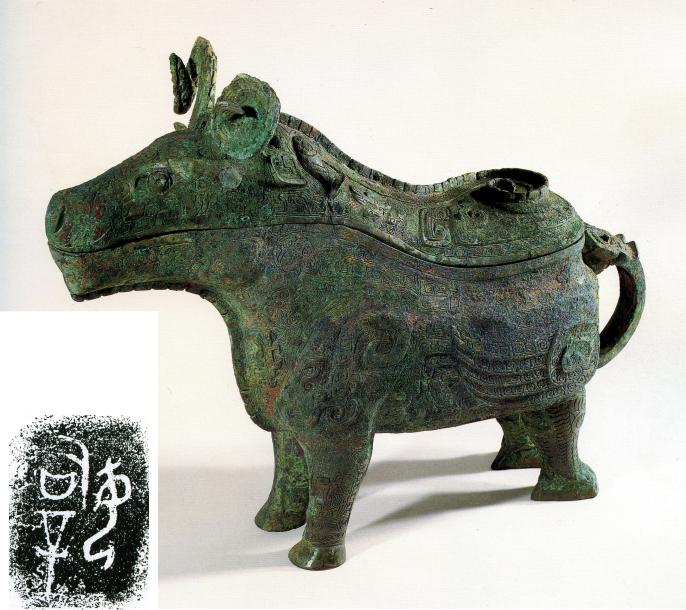
Simu Xin Four-legged Gong

Simu Xin four-legged goblet, bronze wine vessel, late Shang Dynasty, 36 cm high, 46.5 cm long, 13.7 cm high lid, 8.5 kg weight. Unearthed from Fu Hao's Tomb in Yinxu, Anyang, Henan Province in 1976. Now in the collection of Henan Museum.
In 1976, a well-preserved tomb of aristocrats from the late Shang Dynasty, Fu Hao's Tomb, was discovered in the northwest of Xiaotun, Yinxu, Anyang. Simu Xin four-legged goblet in the collection of Henan Museum came from this tomb. The shape of this vessel is rather peculiar, standing in a standing position. It has a wide and long spout with a small round hole at the front end of the spout, and a door ridge under the spout that goes straight to the chest. It has a flat and long body, narrow in front and wide in the back, and the middle of the bottom is slightly bulging outward. It has four legs, and the front two legs have animal-shaped hooves, which are slightly longer than the back legs. The outer side of the feet are decorated with Kui patterns, and the Kui mouth is facing downward, and the inner decoration is not very clear; the back two legs are like bird feet, decorated with feather patterns, with four claws, and there is a concave pouring mouth at the bottom of the feet. Handle with animal head. The two sides of the spout seem to be decorated with Kui patterns, but they are not very clear. There is an inverted Kui on each side of the chest. There is a Kui on each side of the front end of the abdomen (i.e. the upper part of the front foot), with the head facing down, the body and tail standing up, and the tail tip curled inward; the back end of the abdomen has two wings close together and a short tail drooping, which seems to be a whole with the hind feet. The inner wall of the handle is decorated with negative lines of animal face patterns. There is an inscription of "Si Mu Xin" in the middle of the bottom. There are traces of silk fabric on one side of the abdomen.
Figure 1 Simu Xin four-legged goblet viewed from above and from the side
The front end of the lid is like a horse head, but there is a pair of large curled horns on the head. The lid is decorated with a dragon pattern, with a large head and round eyes, blunt horns and a long body and tail, and a door-shaped ridge in the middle. On the right side of the dragon body is a Kui pattern, with its mouth facing the spout end, a very long body and tail, two feet bent forward, and four claws, which is quite peculiar; the right side is decorated with monster patterns and Kui patterns respectively. There is a small opening around the lower edge of the lid, which fits with the mouth of the vessel. There is an inscription of "Simu Xin" on the rear end of the lid.
Figure 2 Detailed decoration of Simu Xin four-legged goblet
Top: left abdomen Bottom: right side of the lid
Figure 3 Inscriptions on the body and lid of Simu Xin four-legged goblet (specimen 803)
The scale of Fu Hao's tomb is not large, but the tomb chamber is well preserved, and the burial objects are extremely rich and exquisite. It is the first tomb in the late Shang Dynasty in the history of Yinxu excavation that can accurately determine the owner and the age of the tomb. Because the owner and the age of the tomb are relatively clear, the unearthed objects are rich and the combination is complete, it is of great value for studying the history of the late Shang Dynasty, especially the relationship between politics, economy, handicrafts, culture and art and the state or tribe during the Shang King Wu Ding.


![8.3"China Shang Dynasty,Bronze wine cup [Fuhao Jue cup][妇好爵杯]](http://bronzc.com/cdn/shop/files/4ee0482982cfa89bb4d1cff3333a55e6_e3ca0b86-22fc-497d-9afd-578c551225a3-2.jpg?v=1733986652&width=533)

![12.8" China Ming Dynasty, Phoenix-patterned bronze vase[Ming Wanli Phoenix-patterned vase][明万历凤纹瓶]](http://bronzc.com/cdn/shop/files/4ee0482982cfa89bb4d1cff3333a55e6_a516991b-2bb9-4b2f-a2b6-4354129d006c.jpg?v=1733986953&width=533)

![14.6" China Eastern Han Dynasty Bronze vessel in the shape of a flying horse,Also known as bronze galloping horse[Horse Stepping on Flying Swallow][马踏飞燕]](http://bronzc.com/cdn/shop/files/4ee0482982cfa89bb4d1cff3333a55e6_aa3fbeb8-e08b-4a44-929a-13411ca8fb17-2.jpg?v=1733987211&width=533)

![5.9"China Tang Dynasty, Bronze of a walking dragon[Tang Walking Dragon][唐走龙]](http://bronzc.com/cdn/shop/files/2_8cb416b9-ebbd-4fe2-a905-b9277f820c16.png?v=1731488701&width=533)
